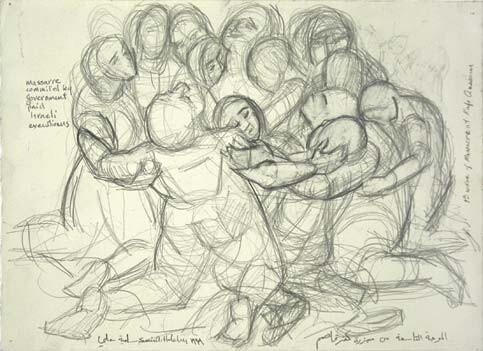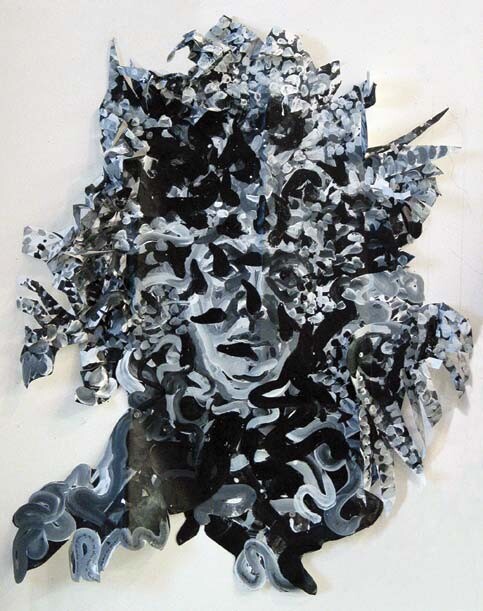The Electronic Intifada 31 May 2006

“The Ninth Wave of Killing” by Samia Halaby, part of her Kafr Qasem Massacre series, 1999.
Three Arab Painters in New York is an art exhibition that features the work of three leading New York-based Arab painters. Samia Halaby, Sumayyah Samaha and Athir Shayota have been contributing to contemporary American art for decades and have exhibited in museums and galleries throughout the United States. Varied in style, technique, medium, scale and artistic influence, the three present a glimpse into the diverse and complex nature of the Arab World’s art and visual culture. Three Arab Painters in New York provides the rare opportunity for the engagement of an American audience with Arab art that explores sociopolitical issues currently affecting the Arab world and its expatriates.
Three Arab Painters in New York will be open from June 3 through June 24, 2006, at The Bridge Gallery, at 521 W. 26th St. in New York City, the recent host of the “Made in Palestine” art exhibition. The show, curated by Maymanah Farhat, is sponsored by Al Jisser Group. An opening reception for the exhibition will be held on Tuesday, June 6, at 6:00 PM. Palestinian artist Samia Halaby, profiled below, joins Lebanese artist Sumayyah Samaha and Iraqi artist Athir Shayota in the exhibition.
Samia Halaby

Palestinian artist Samia Halaby paints outside Salfit. Halaby’s work is featured in “Three Arab Painters in New York.”
“Palestine is full of epic subject matter. It seems that anywhere you look, any person you question or any door you knock at reveals subject matter fitting for great art.”
Samia Halaby advocates the Palestinian cause through her art. Her revolutionary spirit has inspired audiences, artists, activists and scholars. She reinvents herself through her work and activism, each reinvention redefining the boundaries of art and political advocacy. With such works as those in the Kafr Qasem Massacre series, 1999, and I Found Myself Growing Inside an Old Olive Tree, 2005, Halaby articulates the strength of a population refusing to accept a violent occupation.
The artistic process through which I Found Myself Growing Inside an Old Olive Tree was created displays the complexity of Halaby’s creativity. The acrylic painting exhibits the innovative employment of light and structure with the use of black and white paint in vibrant abstractions that fascinate the viewer with the appearance of multiple dimensions and forms that seem to rise from the canvas.

“I Found Myself Growing Inside an Old Olive Tree,” a self-portrait by Palestinian artist Samia Halaby, 2005.
With I Found Myself Growing Inside an Old Olive Tree, Halaby produced a self-portrait that communicates the intimate connection she feels towards her native Palestine. The piece is 36” x 24” and was created in response to an open invitation from the ArtCar Museum in Houston, Texas for artists to submit self-portraits to an exhibition titled “Face.” After spending a week in Al Ramah’s olive orchards in Galilee painting its olive trees, Halaby was drawn to what she describes as “the experience of these olives trees, and the way in which they share our fate as Palestinians.” When she returned to her studio in New York and found the open invitation, she began to use acrylic and tyvek to recount her experience in Galilee.
Amidst the fluidity of white, gray and black brushstrokes, lies Halaby’s face staring directly at the viewer. The brushstrokes that surround the artist’s face are leaf-like, while the lower portion of the piece shows elegantly gnarled roots. Halaby is partially covered by foliage; roots ascend into the lower portion of her self-portrait while leaves and branches revolve in midair around her face. The brushstrokes that outline Halaby are indistinguishable from the throng of olives that dominate the focal point of the piece.
“It seems to tell people just what I experienced there with the ancient olive trees about which I began to feel very sisterly, as though they were accepting me into some ancient collective of those who have seen tragedy and joy.”
As the title suggests, Halaby’s being is concentrated in both the physical and metaphorical elements of the olive tree. For many Palestinians, olive trees are life-giving ciphers that denote their tie to the homeland they continue to be expelled from. The use of a limited color palette suggests Halaby’s return to an organic state of existence; the emphasis is on the unification of self with the foundation of her identity and origin of life.
The Ninth Wave of Killing and Muhammad Habib Musarwa are conte crayon drawings on paper that are part of the eighteen-piece Kafre Qasem Massacre series, which documents the horrifying accounts of forty-nine people that were killed by the Israeli military in Kafr Qasem in 1956. Halaby created the drawings after visiting the Palestinian village during the mid 1990s, where she interviewed residents about the events that had taken place nearly forty-five years before. Through extensive research conducted with the assistance of Kafr Qasem residents, written recordings of the event and photographs of the deceased, Halaby was able to carefully reconstruct the individual moments of the massacre.

“Muhammad Habib Musarwa,” by Samia Halaby, part of her Kafr Qasem Massacre series, 1999.
Halaby describes The Ninth Wave of Killing as depicting the moment when “sixteen women were shot over and over again until only one survived. The sole survivor was in the center of the big hug that the women created as they were being shot.” Some called this event in the massacre “The Dance of Death” because when the shooting began the women came together and began to rotate slowly as bullets hit them. The drawings employ a documentary style method reminiscent of Renaissance drawing. Halaby’s forms are composed of vigorous sketches in a way that connotes a sense of continual movement. The use of such a technique not only records one of the most chilling moments of the massacre but also shows victims in the moments before death. The image haunts the viewer, as the circle of victims is in continual rotation, struggling to protect the sole survivor. The composition of The Ninth Wave of Killing is simple yet the power of Halaby’s documentation lies within the violent nature of drawing that aggressively depicts each figure.
The drawing Muhammad Habib Musarwa shows a Kafr Qasem resident just after the moment he was shot. After returning to the scene of a shooting in an earlier stage of the massacre, Muhammad Habib Musarwa attempted to cross over a barbwire fence but was shot by Israeli soldiers. Halaby examined every detail of documentation on the event (even the type of fencing through which he was killed) in order to recreate a visual representation of what occurred moments before his death. By doing so, Halaby honors the murdered residents of the village with the dignity of telling their stories. The killings documented in Halaby’s series expose both the vulnerability and potential callousness of humanity, reminding the viewer that beyond political conflict are civilian lives that continue to be caught under the violent siege of the Israeli occupation.
Despite the aggressive use of bold lines and vigorous sketching, Halaby’s figures emanate with the fragility of defenseless victims caught in a cyclone of hostility. Humanity juxtaposed against cataclysmic violence reminds the viewer of the most devastating aspects of political conflict, the tragic loss of innocent lives.
Exhibition Information:
Gallery: The Bridge
521 West 26th Street, 3rd Floor (between 10th and 11th Aves) New York, NY 10001
Telephone: 646-584-9098
Exhibition Dates: June 3-24, 2006
Open Tuesday to Saturday 11:00am-6:00pm
Admission Free
Opening Reception: Tuesday June 6, 2006. 6:00pm-9:00pm
Maymanah Farhat is a freelance writer and researcher of visual arts and culture, and is a specialist in Modern and Contemporary Arab art. This piece has been excerpted from exhibition catalog, Three Arab Painters in New York, which is copyrighted to Maymanah Farhat and Al Jisser Group.
Related Links




